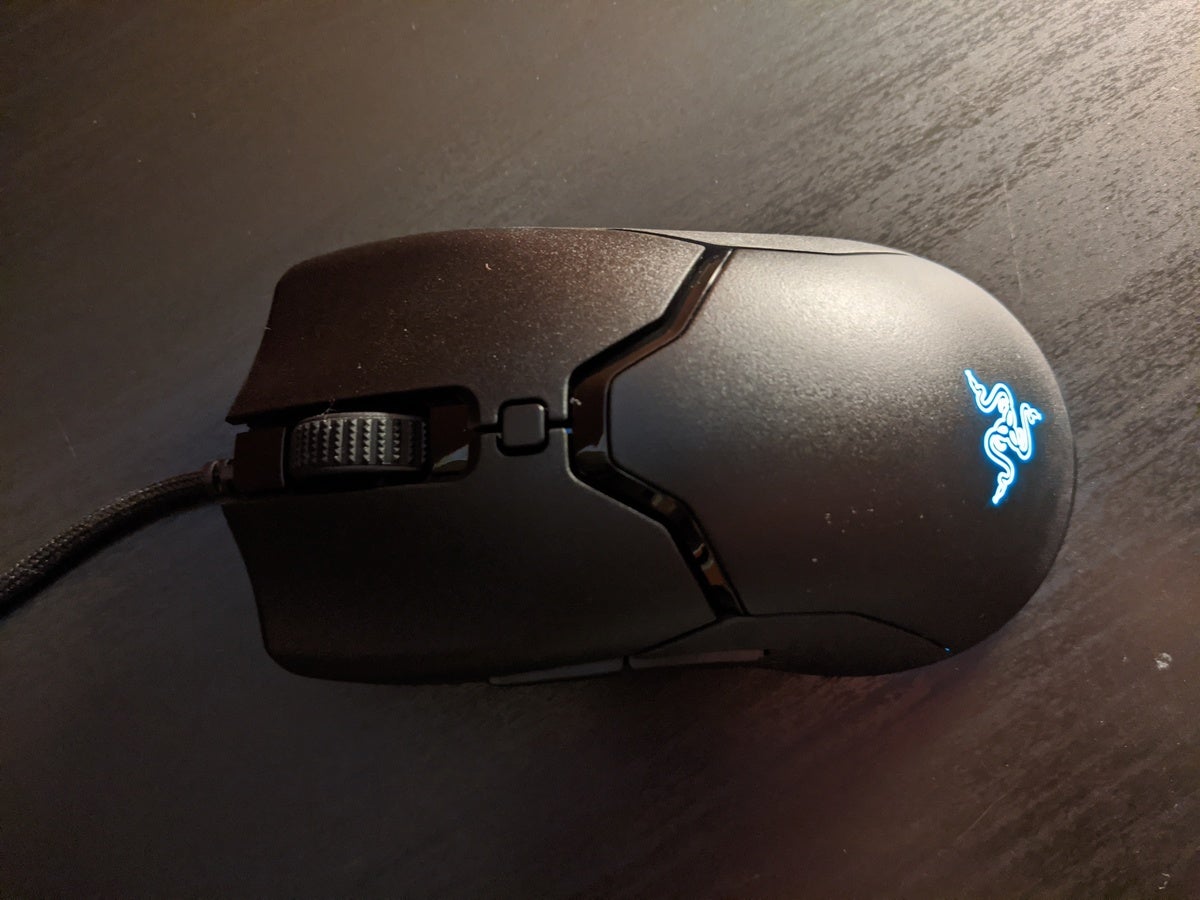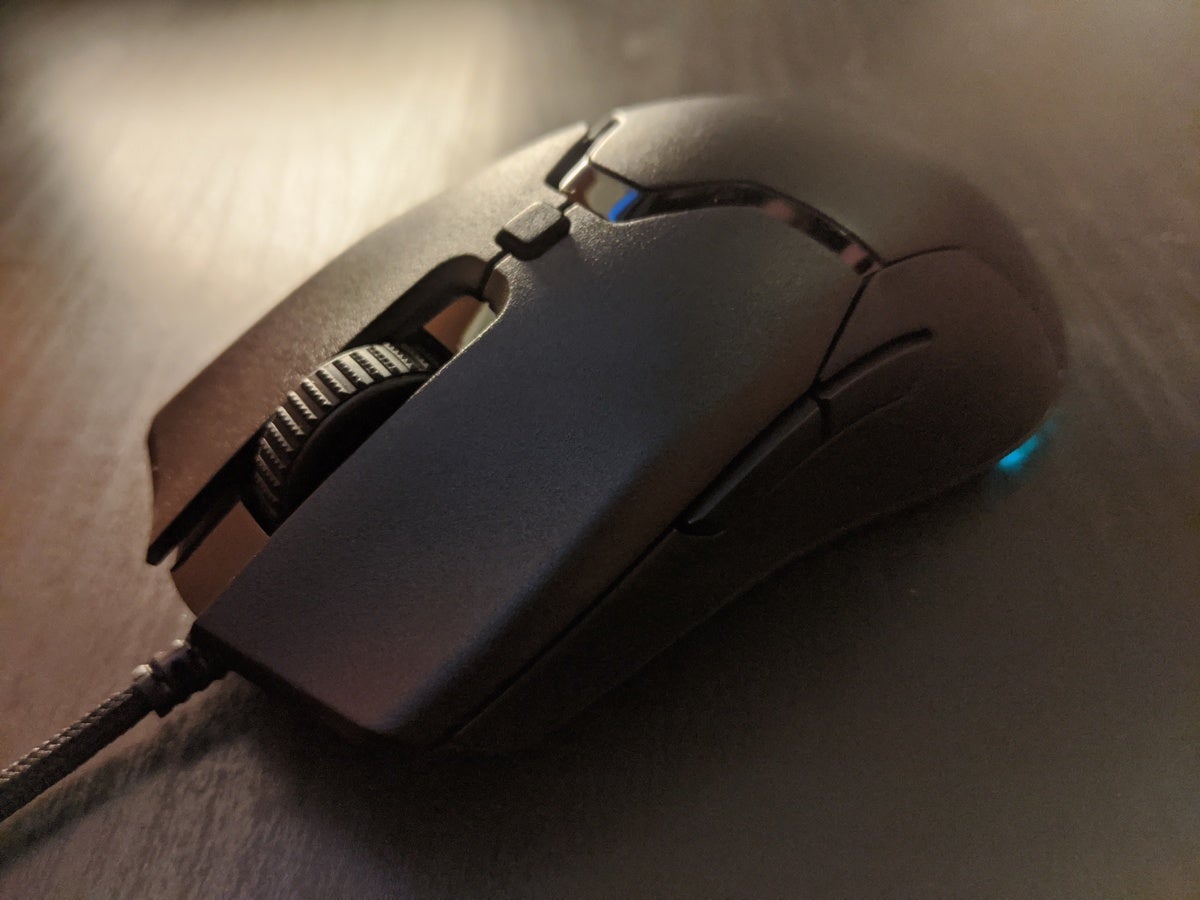When I picked up the box, I thought it was empty. That’s how light Razer’s Viper Mini is, the latest mouse to vie for the featherweight crown. Coming in at a mere 61 grams, or 2.1 ounces, it feels less like a mouse and more like a prototype, an empty plastic shell. It’s hard to believe there’s actual hardware under the hood—and yet it’s a proper gaming mouse.
And in this case, small size is paired with a similarly small price tag. The Viper Mini can be yours for just $40. That had us asking, “What’s the catch?” Is there a catch? Read on to find out.
Note: This review is part of our roundup of best gaming mice. Go there for details on competing products and how we tested them.
Tiny terror
Okay, caveat number one: It’s very small. Obviously that’s by design. It’s the Razer Viper Mini. I am not a small person though, and I find the Viper Mini too narrow for all-day use. The original Viper’s faux-ambidextrous (symmetrical, but not intended for left-hand use) chassis measured approximately 2.6 inches left-to-right. The Viper Mini is just over 2 inches across. It’s enough of a difference that I find not just my pinky but my entire ring finger dragging across the mousepad.
 IDG / Hayden Dingman
IDG / Hayden DingmanThe Viper Mini is shorter too, at 4.6 inches to the original’s 4.9. Nevertheless, it’s the width that causes me the most trouble. It’s comfortable enough in short bursts, but after an hour or so my hand starts to cramp.
Let me be clear: I’m not penalizing the Viper Mini for its size. The majority of mice cater to my big mitts, while very few suit people with smaller hands. I can think of a few friends who might be excited by the Viper Mini. But it’s an important caveat, as we dig into discussions of weight. The Viper Mini is Razer’s “lightest mouse yet,” but it’s not exactly standing toe-to-toe with Razer’s full-sized DeathAdder or the Basilisk.
It’s a hell of a lot lighter than either of those though. By contrast, the DeathAdder weighs in at 3.7 ounces and the Basilisk at 3.8 ounces. My beloved Logitech G502 is 4 ounces. The Viper Mini is definitely lightweight.
That said, so was the original Viper, which weighed in at 2.4 ounces. That renders the Viper Mini’s 2.1 ounces slightly less impressive, insofar as the Viper is a full-sized mouse and the Viper Mini is 3/4-scale. It’s not as if Razer trimmed substantial weight off the design here. Given the reduction in footprint, a .30 ounce difference actually seems fairly tame.
 IDG / Hayden Dingman
IDG / Hayden DingmanBut the Viper Mini only suffers in comparison to the Viper, and that’s not fair. Both have incredibly impressive specs if you’re used to standard (read: heavy) gaming mice and on the hunt for something lighter. The Viper Mini is almost as light as mice like the Air58 Ninja, at a fraction of the price and without the honeycombed chassis common with ultra-lightweight devices.
Me? I prefer a heavier mouse, and find the Viper Mini a bit insubstantial. But as with the size, that’s personal preference. Razer set out to make a lightweight mouse, and then did it, and it’s not up to me to condemn the Viper Mini for that.
What can I judge the Viper Mini on, then?
First of all, the switches. Like the DeathAdder V2, the Viper Mini uses Razer’s optical mouse switches. And hey, they’ve started marketing them correctly! Sure, there’s still a mention of optical switches being “three times faster” than boring ol’ mechanical switches (a near-meaningless metric), but that’s no longer the central part of Razer’s sales pitch.
Instead Razer’s focusing on the aspect that matters, i.e. durability. Optical switches are less prone to wear and tear than traditional metal circuits, because a laser won’t break no matter how hard or how often you mash on it. As I said when reviewing the DeathAdder V2, I don’t think optical switches are a rush-out-and-buy upgrade. The current models are stiff and loud compared to mechanicals. I do think they’ll eventually become standard though, because why not? I’m not prone to breaking mice, but the added resilience is still welcome.
 IDG / Hayden Dingman
IDG / Hayden DingmanThe Viper Mini also uses Razer’s new SpeedFlex cable, easily the best cabling option around today. As I wrote in our DeathAdder V2 review:
At this point I’ve completely changed over to wireless mice for day-to-day use, thanks to Logitech’s PowerPlay charging tech. That said, if I were still using wired mice, this cabling is what I’d want on every single mouse I own.
It’s supple, both the fabric sheathe and the wiring inside. It doesn’t kink. It doesn’t tangle. It doesn’t catch on anything. It’s the best cabling solution I’ve tested short of, you know, not having a cable at all.
So yeah, high praise.
The only real downside to the Viper Mini is the sensor. Whether to cut down on price or on weight, I don’t know, but Razer has opted not to use its top-tier PMW 3360 spinoff, the 3389 sensor (also known as the Razer 5G Optical).
Instead, the Viper Mini uses a PMW 3359—which, as far as I can tell, was invented specifically for this mouse. Numbers aren’t everything, but they do indicate this is a budget sensor. Where Razer’s 3389/5G Optical sensor hits 16,000 DPI, the 3359 tops out at 8,500. Maximum speed has also taken a hit, with the Viper Mini capped at 300 inches-per-second compared to the 3389’s 450.
Does it matter? Probably not. Having tested the Viper Mini and the 3359 both with some basic benchmarks and in-game, it seems every bit as capable as the 3360/3389 (up to the DPI cap at least). That’s what I expected, really. Nowadays I’d be surprised if any mouse sensor gave people problems.
 IDG / Hayden Dingman
IDG / Hayden DingmanStill, I find it weird Razer opted for a budget sensor. I’ve seen a lot of people asking for a Viper Mini the past few months, and presumably they wanted a full-blooded Viper Mini with the original 3389 sensor. The same mouse as the Viper, only smaller. Compromising the Viper Mini’s performance—even if only on paper—seems like a strange choice to make along the way.
Part of me wonders if it’s intended (at least in part) for kids. Small, lightweight, cheap—the Viper Mini could be an up-and-comer’s first gaming mouse. Maybe I’m reading too much in to a few unrelated choices, but…well, I’m curious.
Bottom line
I don’t mean to sound dismissive of the Viper Mini. It’s not only for kids. That just seems like a side-benefit, accidental or not.
As I said, there aren’t many options for people with smaller hands, and the Viper Mini seems like a solid newcomer. I wish Razer had used its tried-and-true sensor instead of a cheap alternative, but aside from that, it’s a sturdy mouse that should survive a lot of wear and tear, and at $40 it’s about as budget-friendly as you can get for a name-brand gaming mouse.

